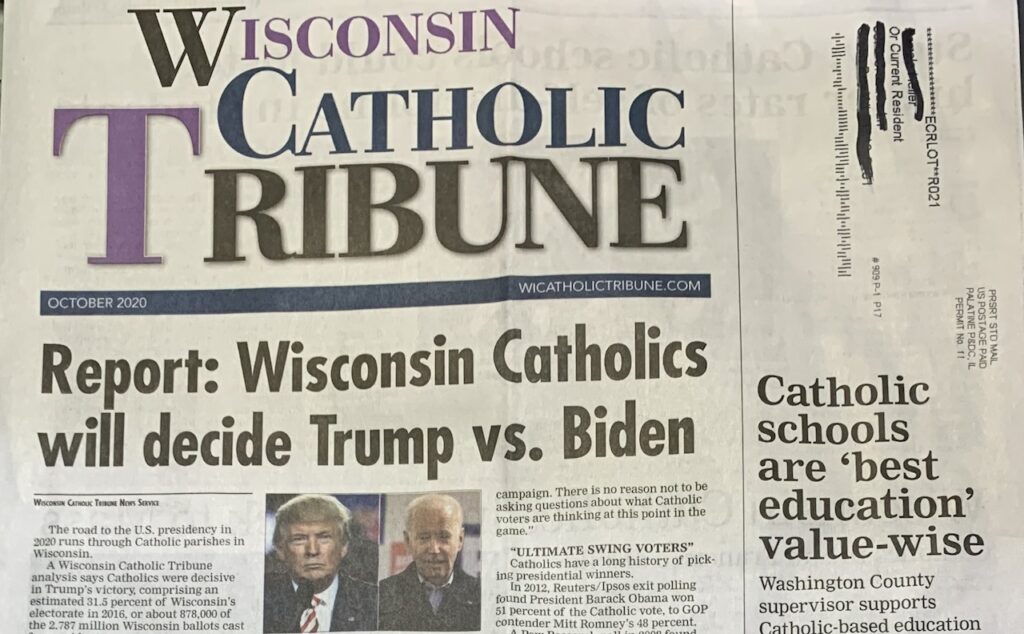(OSV News) — A number of U.S. Catholic dioceses and their bishops have issued statements disavowing fake Catholic newspapers that have resurfaced in swing states ahead of the presidential election to target Catholic voters on key issues.
The publications, which were initially produced ahead of the 2020 presidential election, highlight the rise of what communications scholars call “pink slime” journalism – while running afoul of both canon law on the use of the name “Catholic” and U.S. tax code banning churches and other tax-exempt nonprofits from engaging in partisan politics.
In an Oct. 20 article, ProPublica, an investigative journalism nonprofit, noted the resurgence of the “Catholic Tribune” in several states, including Michigan, Nevada, Arizona, Pennsylvania and Wisconsin. Those states are among the crucial swing states in the 2024 election and will determine which candidate reaches the requisite 270 electoral college votes needed to win the presidency.
The publication, issued in direct print mailers and available online, features a traditional-looking newspaper format, minus an actual masthead listing the publisher, editors and writers.
The digital version of the Catholic Tribune – which like its printed counterpart is tailored for each state, with a uniform design for all of its websites – appears to draw on diocesan and parish directories, social media posts and press releases for the bulk of its content, much of which is outdated on several sites. An apparently national site, AmericanCatholicTribune.com, features more current material drawn from other Catholic news outlets.
Yet interspersed with news of clerical appointments, college panel discussions and Mass intentions are articles – overwhelmingly without bylines or original reporting – that urge readers to take action at the polls on issues such as abortion and religious liberty.
ProPublica observed that a print version of the Wisconsin Catholic Tribune actively sought to “undermine Vice President Kamala Harris and prop up former President Donald Trump.”
Catholic voters are a key demographic in the swing states, and nationally, they are often more evenly divided than other Christian voters. For example, in 2020, about 49% of Catholic voters supported Trump while about 50% supported President Joe Biden, according to data from the Pew Research Center.
Pennsylvania, with its 19 electoral votes, is a state both candidates have campaigned in heavily, and will likely play a key role in whether Harris or Trump is elected to the White House. Exit polls in 2020 showed that 30% of respondents who voted in Pennsylvania’s election that year identified as Catholic.
Michigan, Wisconsin and Pennsylvania all supported Trump in 2016, leading to his election as president, but those same Rust Belt states voted against him in 2020 to support Biden.
An Oct. 21 Washington Post-Schar School poll found Harris and Trump in tight contests in each of the seven battleground states, which also include North Carolina and Georgia.
Several bishops and dioceses have slammed the Catholic Tribune newspapers for deceptively claiming to represent the Church’s interests, among them the Wisconsin Catholic Conference, the Archdiocese of Detroit and the Diocese of Reno, Nevada.
In a statement posted to its website, the Archdiocese of Detroit said it was “aware that the Michigan Catholic Tribune, a newspaper falsely identifying itself as Catholic, is being mailed to parishioners in some areas” of that state.
“This publication is not endorsed by, nor is it affiliated with the Archdiocese of Detroit,” said the statement, noting that the archdiocese had not shared any mailing information with the publication’s organizers.
In addition, the archdiocese pointed out that, to its knowledge, the Tribune “does not have the proper authorization required by Canon (Church) law to call itself Catholic.”
Canon 216, which the Archdiocese of Detroit cited in its statement, specifies that while “all the Christian faithful have the right to promote or sustain apostolic action even by their own undertakings, according to their own state and condition … no undertaking is to claim the name Catholic without the consent of competent ecclesiastical authority.”
The Internal Revenue Service prohibits “all section 501(c)(3) organizations” from “directly or indirectly participating in, or intervening in, any political campaign on behalf of (or in opposition to) any candidate for elective public office.” Failure to comply could result in an organization’s loss of tax-exempt status as well as tax penalties.
Through tax documents and business filings, ProPublica said it had “traced the papers to a Chicago-based publishing network led by former TV reporter Brian Timpone.”
Over the last two decades, Timpone and other partners have assembled several networks of “pay for play” news, where advertising, political partisanship and – in the case of Timpone’s Journatic enterprise – admitted plagiarism and overseas outsourcing using false bylines have clouded the news stream.
Timpone, who has not yet responded to OSV News’ email and voicemail requests for comment, has long been on the research radar of the Tow Center for Digital Journalism at the Columbia Journalism School.
Since 2019, Priyanjana Bengani, a fellow at Tow, has tracked the spread of “partisan outlets masquerading as local news organizations” with algorithmically generated stories as a tactic of electoral disinformation.
With many legitimate local news outlets folding due to lack of funding, such “pink slime” publications (borrowing a former U.S. Department of Agriculture scientist’s term for commercial meat filler) have steadily expanded to fill the vacuum, particularly ahead of elections, Bengani said in a 2019 article.
In a 175-page report, the Tow Center detailed the case of Metric Media and its Catholic Tribune sites as an example of prolific pink slime journalism.

